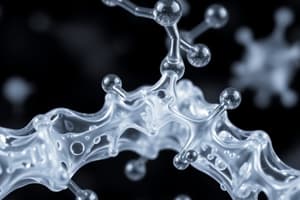Podcast
Questions and Answers
Which class of enzymes primarily catalyzes the transfer of phosphate groups from ATP to substrates?
Which class of enzymes primarily catalyzes the transfer of phosphate groups from ATP to substrates?
- Hydrolases
- Oxidoreductases
- Phosphatases
- Kinases (correct)
What is a major limitation of early enzyme classification based on the suffix --ase?
What is a major limitation of early enzyme classification based on the suffix --ase?
- It fails to describe the catalytic mechanisms accurately. (correct)
- It does not account for enzymes with mixed functions.
- It ignores the substrate specificity of enzymes.
- It mistakenly groups all enzymes under one category.
Which class of enzymes is responsible for breaking apart substrates by adding a phosphate group?
Which class of enzymes is responsible for breaking apart substrates by adding a phosphate group?
- Ligases
- Kinases
- Phosphatases
- Phosphorylases (correct)
How are the major classes of enzymes organized according to the Enzyme Commission classification system?
How are the major classes of enzymes organized according to the Enzyme Commission classification system?
What was added to enzyme classification in 2018?
What was added to enzyme classification in 2018?
Which of the following is NOT a function of oxidoreductases?
Which of the following is NOT a function of oxidoreductases?
What is the main reason enzymes may have been reclassified over time?
What is the main reason enzymes may have been reclassified over time?
Which of the following correctly matches an enzyme class with its action?
Which of the following correctly matches an enzyme class with its action?
What is the primary function of transferase enzymes?
What is the primary function of transferase enzymes?
Which of the following statements is true regarding substrates in transferase reactions?
Which of the following statements is true regarding substrates in transferase reactions?
How do transferases differ from hydrolases?
How do transferases differ from hydrolases?
What distinguishes acyltransferases from other transferases?
What distinguishes acyltransferases from other transferases?
What is a common characteristic of transferase reactions?
What is a common characteristic of transferase reactions?
Which of the following is NOT an example of a transferase reaction?
Which of the following is NOT an example of a transferase reaction?
Which functional group is commonly transferred by methyltransferases?
Which functional group is commonly transferred by methyltransferases?
In transferase reactions, what role does the functional group donor play?
In transferase reactions, what role does the functional group donor play?
What is the primary function of receptor enzymes?
What is the primary function of receptor enzymes?
What happens when an agonist binds to a receptor enzyme?
What happens when an agonist binds to a receptor enzyme?
Which type of residues do receptor tyrosine kinases (RTKs) phosphorylate when activated?
Which type of residues do receptor tyrosine kinases (RTKs) phosphorylate when activated?
What is an important feature of receptor tyrosine kinases regarding their structure?
What is an important feature of receptor tyrosine kinases regarding their structure?
What allows phosphotyrosine (pTyr) to act as a potent intracellular signal?
What allows phosphotyrosine (pTyr) to act as a potent intracellular signal?
What process is involved in downstream signal propagation mediated by pTyr?
What process is involved in downstream signal propagation mediated by pTyr?
Which two types of enzymes do most receptor enzymes belong to?
Which two types of enzymes do most receptor enzymes belong to?
How does the catalytic domain of receptor enzymes typically behave until an agonist binds?
How does the catalytic domain of receptor enzymes typically behave until an agonist binds?
What do kinases primarily transfer to a substrate molecule?
What do kinases primarily transfer to a substrate molecule?
What is the main function of phosphorylases in biochemical reactions?
What is the main function of phosphorylases in biochemical reactions?
Which of the following is an example of a reaction catalyzed by transaminases?
Which of the following is an example of a reaction catalyzed by transaminases?
In the reaction catalyzed by glycogen phosphorylase, which compound acts as the acceptor?
In the reaction catalyzed by glycogen phosphorylase, which compound acts as the acceptor?
Which of the following statements best describes the behavior of polymerases?
Which of the following statements best describes the behavior of polymerases?
What is the primary difference between phosphorolysis and hydrolysis?
What is the primary difference between phosphorolysis and hydrolysis?
Which type of enzyme is involved in transferring the γ-phosphate group in the reverse reaction of phosphorylation?
Which type of enzyme is involved in transferring the γ-phosphate group in the reverse reaction of phosphorylation?
Why are transaminases considered transferases even though their reactions can be considered redox reactions?
Why are transaminases considered transferases even though their reactions can be considered redox reactions?
What reaction does a mutase catalyze?
What reaction does a mutase catalyze?
Which of the following describes configurational isomers?
Which of the following describes configurational isomers?
What is a characteristic feature of protein disulfide isomerases?
What is a characteristic feature of protein disulfide isomerases?
What type of configuration do most peptide bonds favor?
What type of configuration do most peptide bonds favor?
What is the role of phosphoglycerate mutase in glycolysis?
What is the role of phosphoglycerate mutase in glycolysis?
Which statement about aldoses and ketoses is true?
Which statement about aldoses and ketoses is true?
Why can proline residues in peptide bonds exist in both cis and trans configurations?
Why can proline residues in peptide bonds exist in both cis and trans configurations?
What is a typical feature of a redox process facilitated by certain isomerases?
What is a typical feature of a redox process facilitated by certain isomerases?
What type of reaction do hydrolases catalyze?
What type of reaction do hydrolases catalyze?
Which of the following statements about proteases is correct?
Which of the following statements about proteases is correct?
How can hydrolases typically be identified?
How can hydrolases typically be identified?
What differentiates polymerases from ligases?
What differentiates polymerases from ligases?
Which enzyme is specifically known for hydrolyzing phosphate groups?
Which enzyme is specifically known for hydrolyzing phosphate groups?
Which of the following best describes the action of kinases?
Which of the following best describes the action of kinases?
What is a characteristic of most hydrolases in terms of naming?
What is a characteristic of most hydrolases in terms of naming?
Which reaction is an example of a hydrolysis reaction catalyzed by hydrolases?
Which reaction is an example of a hydrolysis reaction catalyzed by hydrolases?
Flashcards
Enzyme Classification
Enzyme Classification
Enzymes are grouped based on the type of chemical reaction they catalyze.
Kinases and Phosphatases
Kinases and Phosphatases
Enzymes ending in '-kinase' add a phosphate group to a molecule, while those ending in '-phosphatase' remove a phosphate group.
Enzyme Classification System
Enzyme Classification System
The Enzyme Commission created six major classes of enzymes, with a seventh class added in 2018.
Oxidoreductases
Oxidoreductases
Signup and view all the flashcards
Transferases
Transferases
Signup and view all the flashcards
Hydrolyases
Hydrolyases
Signup and view all the flashcards
Lyases
Lyases
Signup and view all the flashcards
Isomerases
Isomerases
Signup and view all the flashcards
Functional Group Donor
Functional Group Donor
Signup and view all the flashcards
Functional Group Acceptor
Functional Group Acceptor
Signup and view all the flashcards
Acyltransferases
Acyltransferases
Signup and view all the flashcards
Glycosyltransferases
Glycosyltransferases
Signup and view all the flashcards
Phosphatases
Phosphatases
Signup and view all the flashcards
Hydrolysis vs. Transferase
Hydrolysis vs. Transferase
Signup and view all the flashcards
What are kinases?
What are kinases?
Signup and view all the flashcards
What are phosphorylases?
What are phosphorylases?
Signup and view all the flashcards
What are transaminases?
What are transaminases?
Signup and view all the flashcards
What are polymerases?
What are polymerases?
Signup and view all the flashcards
Do kinases only work in one direction?
Do kinases only work in one direction?
Signup and view all the flashcards
How are phosphorylases similar to hydrolases?
How are phosphorylases similar to hydrolases?
Signup and view all the flashcards
Why are transaminases important?
Why are transaminases important?
Signup and view all the flashcards
What is the key role of polymerases?
What is the key role of polymerases?
Signup and view all the flashcards
What are transferases?
What are transferases?
Signup and view all the flashcards
What are phosphatases?
What are phosphatases?
Signup and view all the flashcards
What are hydrolases?
What are hydrolases?
Signup and view all the flashcards
What are proteases?
What are proteases?
Signup and view all the flashcards
What are hydrolysis reactions?
What are hydrolysis reactions?
Signup and view all the flashcards
What are isomerases?
What are isomerases?
Signup and view all the flashcards
What are receptor enzymes?
What are receptor enzymes?
Signup and view all the flashcards
What are the two key domains of receptor enzymes?
What are the two key domains of receptor enzymes?
Signup and view all the flashcards
How are receptor enzymes activated?
How are receptor enzymes activated?
Signup and view all the flashcards
What is the common catalytic activity of receptor enzymes?
What is the common catalytic activity of receptor enzymes?
Signup and view all the flashcards
What are receptor tyrosine kinases (RTKs)?
What are receptor tyrosine kinases (RTKs)?
Signup and view all the flashcards
Why is autophosphorylation important in RTKs?
Why is autophosphorylation important in RTKs?
Signup and view all the flashcards
What is the role of phosphotyrosine in RTK signaling?
What is the role of phosphotyrosine in RTK signaling?
Signup and view all the flashcards
How is the signal propagated downstream of RTKs?
How is the signal propagated downstream of RTKs?
Signup and view all the flashcards
What does phosphoglycerate mutase do?
What does phosphoglycerate mutase do?
Signup and view all the flashcards
What are protein disulfide isomerases?
What are protein disulfide isomerases?
Signup and view all the flashcards
What are configurational isomers?
What are configurational isomers?
Signup and view all the flashcards
What are cis/trans isomers?
What are cis/trans isomers?
Signup and view all the flashcards
What are R/S isomers?
What are R/S isomers?
Signup and view all the flashcards
How do peptide bonds exhibit cis/trans configuration?
How do peptide bonds exhibit cis/trans configuration?
Signup and view all the flashcards
Study Notes
Enzyme Classification
- Enzymes catalyze a wide range of biochemical reactions on various substrates, producing diverse products.
- Enzyme classification groups enzymes based on the type of reaction they catalyze.
- An early system named enzymes based on their reaction and added the suffix "-ase".
- This system has limitations, as it doesn't always clearly categorize enzymes with similar reactions but different mechanisms.
- In 1961, the Enzyme Commission classified enzymes into six major classes based on their catalytic mechanism.
- A seventh class was added in 2018.
- Enzyme classification is important for understanding the catalytic mechanisms of enzymes.
Oxidoreductases
- Oxidoreductases catalyze oxidation-reduction reactions, transferring electrons between molecules.
- These enzymes are multisubstrate, requiring both an electron donor and acceptor.
- Redox cofactors or coenzymes (e.g., NAD+/NADH, FAD/FADH2) often change oxidation state during the reaction.
- Crucial in many metabolic pathways.
- The name often reflects the substrate changed.
Transferases
- Transferases catalyze the transfer of a functional group from one molecule (donor) to another (acceptor).
- They typically require two substrates (donor and acceptor).
- Water cannot be the acceptor.
- Includes kinases (transfer phosphate groups), acyltransferases (transfer fatty acyl groups) and glycosyltransferases (transfer carbohydrates).
- Important for metabolic processes involving functional group transfer.
Hydrolases
- Hydrolases catalyze the cleavage of a bond with the addition of water.
- The reaction involves breaking a bond and adding water.
- Important in many metabolic pathways for breaking down large molecules.
- Named after the substrate or the functional group acted upon (e.g., esterases, glycosidases).
Lyases
- Lyases catalyze the addition or removal of a functional group to/from a double bond.
- Do not use hydrolysis or redox rxns.
- Include mechanisms involving elimination reactions or addition across double bonds.
- Examples include enzymes involved in, glycolysis, fumarate hydratase.
Isomerases
- Isomerases catalyze reactions that change the structure of a single substrate without altering its net composition and type of atoms.
- These reactions can result in constitutional or configurational isomers.
- Examples include triose phosphate isomerase, mutases.
Ligases
- Ligases catalyze the joining of two molecules using the hydrolysis of ATP (or other nucleoside triphosphates).
- This reaction involves joining two molecules (synthases).
- Important in processes requiring energy investment to create a new bond between two molecules (e.g., in DNA repair or synthesis).
- Names frequently include "synthetase" or "ligase."
Studying That Suits You
Use AI to generate personalized quizzes and flashcards to suit your learning preferences.




